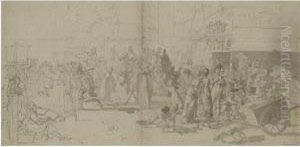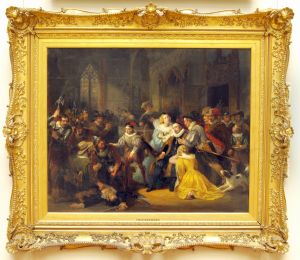Nicolaas Pieneman Paintings
Nicolaas Pieneman was a Dutch painter, engraver, and lithographer who was born on January 1, 1809, in Amersfoort, Netherlands. He was part of the 19th-century European art movement and is best known for his historical paintings and his connection to the Dutch Royal House. Pieneman's father, Jan Willem Pieneman, was also a prominent painter, and it was under his tutelage that Nicolaas began his artistic training.
During his career, Nicolaas Pieneman was deeply involved with the Royal Academy of Fine Arts in Amsterdam, where he served as a professor and later as the director. His works often depicted significant historical events and figures, with a particular focus on Dutch history. Pieneman's style was typical of the Romantic period, characterized by a strong emphasis on emotion and a glorification of the past.
One of his most famous works is the 'Battle of Waterloo' (1824), which earned him considerable recognition. In addition to historical paintings, Pieneman also created portraits of notable individuals, including members of the Dutch royal family. His portrait of King William II of the Netherlands exemplifies his skill in this genre and solidified his status as a court painter.
Throughout his life, Pieneman was honored with various commissions and accolades due to his talent and connections. He was a member of the Royal Netherlands Academy of Arts and Sciences and received several royal commissions which further bolstered his reputation.
Nicolaas Pieneman passed away on December 30, 1860, in Amsterdam, leaving behind a legacy as one of the Netherlands' respected historical painters of the 19th century. His works continue to be studied and appreciated for their historical significance and artistry.







